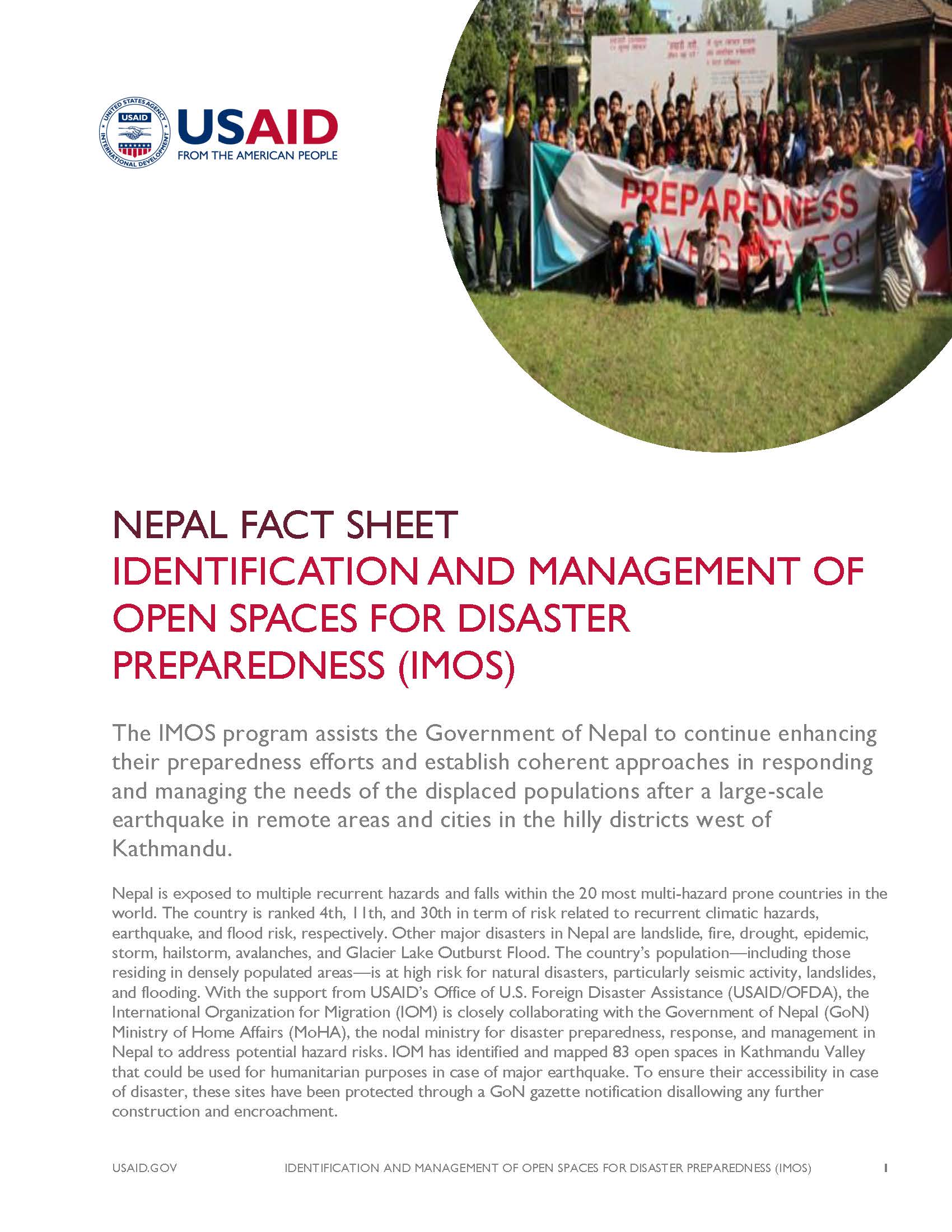The IMOS program assists the Government of Nepal to continue enhancing their preparedness efforts and establish coherent approaches in responding and managing the needs of the displaced populations after a large-scale earthquake in remote areas and cities in the hilly districts west of Kathmandu.
Nepal is exposed to multiple recurrent hazards and falls within the 20 most multi-hazard prone countries in the world. The country is ranked 4th, 11th, and 30th in term of risk related to recurrent climatic hazards, earthquake, and flood risk, respectively. Other major disasters in Nepal are landslide, fire, drought, epidemic, storm, hailstorm, avalanches, and Glacier Lake Outburst Flood. The country’s population—including those residing in densely populated areas—is at high risk for natural disasters, particularly seismic activity, landslides, and flooding. With the support from USAID’s Office of U.S. Foreign Disaster Assistance (USAID/OFDA), the International Organization for Migration (IOM) is closely collaborating with the Government of Nepal (GoN) Ministry of Home Affairs (MoHA), the nodal ministry for disaster preparedness, response, and management in Nepal to address potential hazard risks. IOM has identified and mapped 83 open spaces in Kathmandu Valley that could be used for humanitarian purposes in case of major earthquake. To ensure their accessibility in case of disaster, these sites have been protected through a GoN gazette notification disallowing any further construction and encroachment.
As requested and prioritized by the GoN in the National Disaster Response Framework, IOM will continue to conduct a series of activities replicating the identification and protection of open spaces.
The project “Identification and Management of Open Spaces for Disaster Preparedness (IMOS)” supported by USAID/OFDA aims to assist the GoN to continue enhancing their preparedness efforts and establish coherent approaches in responding and managing the needs of the displaced populations after a large-scale earthquake in the remote areas and cities in the hilly districts west of Kathmandu.
PROJECT OVERVIEW
In coordination with the Ministry of Urban Development’s Department of Urban Development and Building Construction, MoHA, and Ministry of Federal Affairs and Local Development, the IOM-led project promotes identified open spaces and disaster preparedness through outreach campaigns to increase awareness and preparedness levels in at-risk municipalities of Kathmandu Valley, targeting 30 communities around the open spaces in Kathmandu and Bhaktapur Municipality. Key messages will include location of the open spaces and the importance of preparedness in facing large-scale disasters. Upon completion of these activities, information and tools such as standard operating procedures and information, as well as education and communication materials will be handed over to community clubs.
This program promotes and preserves open spaces through outreach campaigns to increase awareness and preparedness levels in Kathmandu Valley, and identifies open spaces in the five cities of Western Nepal (Pokhara, Baglung, Tansen, Putali Bazaar and Tamghas).
PROJECT ACTIVITIES
- Identification of 30 beneficiary communities around the open spaces in consultation with the GoN, humanitarian community, and community members;
- Series of awareness raising and public information campaigns in the selected open spaces and the nearby communities;
- Establishment of 30 temporary coordination and information centers in communities around the selected open spaces;
- Dissemination of information, education & communication) IEC materials and Public Service Announcement concerning the availability of open spaces in Kathmandu Valley;
- Mapping of open spaces in the five cities (Pokhara, Baglung, Tansen, Putali Bazaar and Tamghas);
- Consultation and validation with national and district government authorities, humanitarian actors and civil society on the open spaces identified in the five cities;
- Mapping of essential services such as health, WASH, transport, warehousing, and security services around the identified sites;
- Preparation of detailed technical and GIS maps for the identified open spaces of the five cities;
- CCCM trainings for the district stakeholders of 2015 earthquake-affected 14 districts and 5 municipalities of Western Region.
PLANNED RESULTS
- Reach approximately 15,000 people from 30 communities living around the identified open spaces in Kathmandu and Bhaktapur through awareness campaigns.
- Provide approximately 460,000 people with access to more than 65 identified open spaces in Pokhara Sub-Metropolitan City, Putalibazar Municipality, Baglung Bazar Municipality, Tansen Municipality and Resunga Municipality.
- Train an estimated 350 officials in CCCM.
- Incorporate CCCM module in National Training Programs and academic curriculum of schools.








Comment
Make a general inquiry or suggest an improvement.